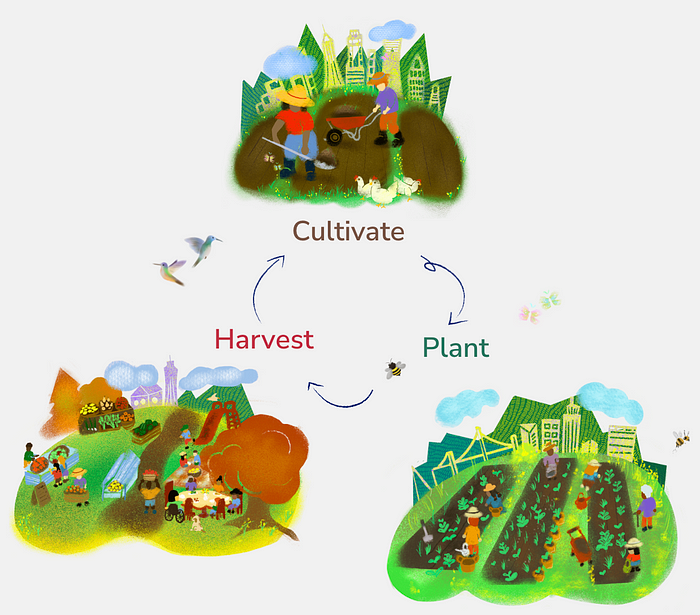Capacity Building Moment #4: Cultivate, Plant, Harvest, Repeat: Updates to HIP’s Health Equity Guide
By Victoria A. Davis

For the last 7 years, the Health Equity Guide has been a go-to resource for public health practitioners, supporting the planning and implementation of equity strategies across the country.
In 2017, HIP launched the Health Equity Guide, a comprehensive online resource of strategic practices and case studies, to support health equity work within governmental public health. However, since its release, we’ve seen great changes in the context and practice of public health and health equity, most significantly with:
- The COVID-19 pandemic
- National racial justice uprisings against police violence after the murders of George Floyd and Breonna Taylor
- Shifts in government leadership that threaten democracy
Within this shifting context, HIP’s theory and approach to health equity practice have also grown and evolved. In 2023, we knew it was time to revamp this important resource. HIP began a process to update the framing and strategic practices of the Guide to better speak to the current context for governmental health equity work and reflect HIP’s evolved frameworks for effective equity practice. A primary goal of the updates was to create a new organizing framework for the strategic practices that communicate a more strategic and sequenced approach to health equity work. While the primary audience of the Guide remains governmental public health, the framework and practices are widely applicable to health equity work across sectors, because we believe it’s important for us to build a movement across silos that is aligned in both our health equity practices and inside outside strategies.
The result of this process is a new cyclical framework for health equity practice rooted in a planting allegory. Like a gardener tending to the soil and plants, health equity practitioners need to attend to the environment and conditions for their work in order for their strategies to take root, grow, and bear fruit, or have impact in the community. The strategic practices in the Guide have been updated to align with this framework, to make it clearer where and how to begin your equity work; what work is foundational to other strategies; and what strategies support learning from and sustaining health equity work. The three stages of the framework are: Cultivate (foundational equity practices); Plant (internal and external strategies to effect change); and Harvest (evaluating and sustaining equity work).

Gardeners understand that a beautiful and bountiful garden depends on a lot more than what seeds you plant into the ground. Successful gardening requires creativity in navigating the environment around you. Like gardening, health equity is a practice that takes time and requires a commitment to continued learning and unlearning, nurturing, and growing, as individuals, in teams, and with communities.
In the updated Health Equity Guide, we were also inspired by the wisdom of Indigenous communities and their practices of companion planting, Dr. Camara Jones and her allegories, GARE and other organizational change frameworks that center equity, and other storytellers who have used storytelling to inspire change. Our Guide shares a collective story of growth, successes and challenges, and hard work.
The Health Equity Guide is a practical resource for all public health practitioners — whether you’re in governmental public health or work in another sector. These updates have many useful applications for planning, implementation, and evaluation of health equity efforts. Public health practitioners and organizations can use the framework to organize their health equity work and frame strategic plans with short and long term goals.
The updated Health Equity Guide is live! In case you missed HIP’s webinar, you can check out this recording.
Acknowledgements
The Health Equity Guide has been a labor of love since its inception. We are deeply grateful to Megan Gaydos, former HIP staff member who led the development of the original Health Equity Guide, and many other HIP staff for their contributions. The California Endowment funded the original development, and a group of external advisors leant their ideas and expertise to the content and design.
We extend our gratitude to all of the HIP staff who developed content for the updates, and NACCHO and CDC for providing the resources for these updates. Additionally, we are grateful to the designers and web developer who created a beautiful new aesthetic for the Guide. The full acknowledgements for the updates are included in the About page on the website.
Check out CB Moment 3: Building a Container for Equity Work and CB Moment 2: Container Building.
Stay up-to-date on CB Moments and other HIP Capacity Building work by:
- Visiting HIP’s website or HIP’s YouTube channel
- Signing up for HIP’s newsletter
Connect with HIP staff at the American Public Health Association conference this week, or at the Facing Race conference in November by emailing info@humanimpact.org!
To learn more about HIP’s capacity building services, please email cbinfo@humanimpact.org
